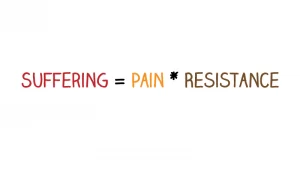 A few years ago, I experienced a break-up which threw me into a profound state of grief, confusion, resentment, bitterness and self-recrimination. What followed thereafter was a year of anguish, and psychological torment to a degree that I had never experienced before. No matter what I tried to do to crawl out of my self-pitying, sad, and indignant hole, nothing seemed to work.
A few years ago, I experienced a break-up which threw me into a profound state of grief, confusion, resentment, bitterness and self-recrimination. What followed thereafter was a year of anguish, and psychological torment to a degree that I had never experienced before. No matter what I tried to do to crawl out of my self-pitying, sad, and indignant hole, nothing seemed to work.
In that very dark and very gloomy year, I went to therapy, I spoke to others who had experienced something similar in their lives, I made various kinds of art, which is something that usually helps me to process and shift tormented states. But at the end of the year, I was very much caught up in the trauma of that sudden and somewhat callous uncoupling, as well as feeling a tad hopeless, in that my usual self-care and spiritual practices (exercise, yoga, learning and reciting poems, meditation, going for walks in nature, cuddles and playing with my doggo Max) weren’t really healing and helping me in the way that they usually did.
More than anything, I realised that I needed to increase or add to whatever strategies I’d been employing, and maybe even try out some things that I had been resistant to doing during the previously.
Below, you will find a handful of self-help techniques that worked for me, in that doing them on a daily basis felt soothing and in time (a great deal of time, but time is also often the secret ingredient here) I managed to re-emerge into my everyday life again with fewer and less disturbing reactions to the painful and lacerating thoughts and emotions connected to this other person and the situation that had brought about our parting of ways.
I’ve called these techniques the KINGS of Self-Help, not because I’m a fan of patriarchal privilege, or the monarchy in general for that matter, but because I needed an acronym to help me remember this handful of life-saving strategies, and also to signal to myself in an archetypal way, that this was the good stuff, the noble, benevolent, and safeguarding stuff that I needed to work on for myself to heal and become whole, in some way, again.
If you’re struggling with a difficult relationship or any other trauma associated with a past or present figure in your life, I would recommend giving some or all of these techniques a go. Not just once or twice, but maybe for a few weeks, on a daily basis. None of these practices take longer than 5-10 minutes to carry out. You can either focus on just one practice, and do that everyday, or do them together as a combination, as I now like to do whilst walking with my dog-pal Max in our local park.
If you’re listening to an audio version of this, you might even play for yourself the instructions and then pause to do the practice itself before moving onto the next one. I really, really hope that some of these help you as much as they have me.
1) K: (LOVING)KINDNESS
 This practice is based on a core psycho-spiritual method in Theravadan Buddhism, as well as other spiritual traditions, called metta, which translates into English as something like friendliness, or goodwill, or taking an active interest in others. I do this practice for about ten minutes a day. It has five parts, so two to three minutes for each piece of it, and here’s how to do it.
This practice is based on a core psycho-spiritual method in Theravadan Buddhism, as well as other spiritual traditions, called metta, which translates into English as something like friendliness, or goodwill, or taking an active interest in others. I do this practice for about ten minutes a day. It has five parts, so two to three minutes for each piece of it, and here’s how to do it.
HOW TO DO IT | Part One: Someone Or Something You Love
Whilst sitting quietly or walking, call to mind someone whom you really care for, someone that it doesn’t take much energy for you to feel a level of warmth and care and affections towards in the depths of your heart. You might even want to place a hand on your heart-centre, the centre of your chest, and really feel that focused love and affection and tenderness that you are able to generate by simply dwelling on the image of, or the remembered presence, or voice, of that other person. But it could also be a pet, or a character in a fantasy or sci-fi novel, or even a deity if you like.
I like to do this first part of the practice, looking at and thinking about my dogchild Max, as well as my aging parents, but it can be really anyone or anything that opens your heart a couple of inches, or even just a few millimetres. Now, whilst holding the image or idea of the loved one in your mind and heart, start to send them some good vibes.
Traditionally, this is done by saying or chanting a few phrases such as: may you be happy, may you be healthy, may you be free from suffering. I like to chant or sing these words out loud, to the tune of a Rex Orange County Song that I like called Loving Is Easy.
So let’s say you were to do this somewhat like I do, start by focusing on your loved one and begin to chant: MYBH, MYBH, MYBFFS, over and over again for about two to three minutes. If you’re doing this whilst out walking, as I like to do, and if another person or living creature (a bird, a squirrel) crosses your path, I find it quite nice to include them too into this sphere of lovingkindness that you are trying to generate and nurture in your heart of hearts. Also, pay attention to what your mind gets up to whilst you’re chanting, especially if it flits off elsewhere, or puts up some resistance to what you’re doing.
“Oh my God, this is a bit naff, why’s he doing this?”
“I don’t know, so boring! I’d prefer listening to a podcast.”
“How many more minutes of this? Surely we’ve done two minutes of this already.”
“I don’t know. Let me see if so-and-so answered my WhatsApp message earlier. I can keep the chant going whilst checking for messages, right?”
Whatever resistance your mind offers to the practice, see if you can accept it with a similar sense of goodwill and friendliness that you’re pumping out of your heart-centre at this moment, and just keep on going for the full two or three minutes.
HOW TO DO IT | Part Two: A Neutral Stranger
For the second part of this practice, we focus on someone who we have no connection to whatsoever. It could be some people in another country that you saw going about their business or suffering on the news the night before; it could be the barista who served you your coffee this morning, or the supermarket assistant who you often see working on the self-checkouts. Just someone you can picture in your mind in some way, or hold as an idea, but who doesn’t necessarily call up any emotions, positive or negative associations for you. Again, spend two to three minutes either repeating in your mind, or out loud the loving mantra: MYBHa, MYBHe, MYBFFS. And as before, notice any disruptions or reactions from your conscious mind in response to the practice.
“Mmm. I thought I felt neutral about that person, but actually there’s something about them that I find a bit offputting.”
“God, this Rex Orange Country tune is starting to annoy me. I hope it doesn’t turn into an earworm.”
“I wonder if Aldi are still selling those biscuits I like half-price?”
HOW TO DO IT | Part Three: A Mixed Bag Relationship
Most of our relationships fall into this category. People we are really fond of but who also rile us in some shape or form. An old friend or a sibling who has lots of positive qualities, but who also manages to elude our attempt to have with them the kind of connection we might personally aspire to having. The relative we feel an attachment to, but winds us up in a way that sometimes feels uncomfortable. That’s the idea here. And, as before, three minutes or whatever amount of time you’ve set for each part, sending some well-wishing in their direction, and working with the resistant or obstructive mind in terms of its response to you dedicating three minutes of your life having some loving thoughts towards someone who doesn’t always act in a loving way towards you.
HOW TO DO IT | Part Four: The Difficult Person, or Enemy
OK, this is a bit like lifting weights. Another 20 kilos added on each time, and maybe this one might be the hardest for us to do. Here we wish health, happiness, freedom from suffering, and all those other sweet and harmonious thoughts to the people we really don’t like, including those people who we feel really don’t like us. This is great to do for any current relationship, or past relationship which has left you with a bitter or anguished taste in your mouth, for those people you might resent in some way, or even at times feel very strong and distressed emotions towards.
Same deal. You might even try imagining these people being happy, healthy and free from suffering, just to see what your mind does with that. It might resist this visualisation. I’ve found that it helps to also bring in a bit of humour here. So whilst I’m imagining my difficult people, I also try and bear in mind the ways that I too can be a pain in the arse at times, but not in a beating myself up, just a little acknowledgement of my own Enneagram Four shaped shadow. We’re all flawed, we’re all constrained in different ways by our personalities or ego-cages, as I prefer to call them. I sometimes also imagine the people in this category doing a little cheerleading squad dance (for themselves) as I chant may you be happy, healthy and free from suffering. This is not to demean them, or make them seem foolish, but it just makes me smile, and gives me a feeling that my enemies are also putting in a little bit of effort in this human quest to live their lives, our lives as happy, healthy, and with as little suffering as possible.
HOW TO DO IT | Part Five: Ourselves
We’ve saved the best, but maybe also the hardest part of the practice for last. After pouring pint after pint of love from our sometimes resistant hearts out for the people we unconditionally care about, as well as those more conditional relationships, we are now ready to do the same for us, and also to notice what inner critics or other obstructions come up as we spend three minutes wishing ourselves well. Can we really get behind this last part, really want the best for ourselves, without our minds coming up with reasons why we don’t deserve it, or how another person or situation is somehow standing in the way of us getting our own pint of happiness, health and freedom from suffering. If this thought arises, again you can just briefly switch to that person or thing and send them another pint of happiness, health, peace and fulfilment. You get the idea. Of course it’s great if you’re able to generate this stuff wholeheartedly each time you do it, but turns out, as far as rewiring those neural networks go, even if you fake it to some extent, say the words, but not have them connect with loving inner feelings, this practice will still work for you. In terms of the Ego and the way it gets trapped in various forms of suffering, it seems that even just alluding to a more loving, open, generative outlook can shift one’s actual outlook in time. Perhaps the Difficult Person or Enemy moves into the less emotional territory in our minds of the Mixed-Bag relationship, or The Neutral Stranger. This is possible, as well as even quite likely, if we persist with this practice on a daily basis.
2) I = INTENTION
 Intention is really where we firm up our trajectory in an area of our life or situation, or person in our life that we’re struggling with in some way. Having done our well-wishing, we now think about all those areas in our life that cause us some upset or suffering and set our intention for the day, or for the next week, or maybe even just for the next hour. Don’t text so-and-so when feeling upset, whatever your intention is. Or: I’m going to move forwards in this relationship or this situation like this rather than that. You might want to imagine yourself standing at a crossroads for each healthy intention you set, and visualise yourself heading perhaps to the right (or left) whichever direction feels like the path of suffering, which is also most likely aligned with our default self-protective fight-flight-freeze stress-reponses versus the other side which is more likely to take us closer to the well-wishing intent of the first practice: allowing us to be as happy as we can be, healthy as we can be (physically and mentally) as well as free from as much mind and heart-generated suffering as possible. So why not try that now? Call to mind an issue, situation or a person you’re struggling with, and set a wise, or skillful, or healthy intention that you are going to follow at least today (you could alter the intention tomorrow), but ideally something which when set and reinforced each day in some way, you can continue to uphold and carry out in the way that best serves you.
Intention is really where we firm up our trajectory in an area of our life or situation, or person in our life that we’re struggling with in some way. Having done our well-wishing, we now think about all those areas in our life that cause us some upset or suffering and set our intention for the day, or for the next week, or maybe even just for the next hour. Don’t text so-and-so when feeling upset, whatever your intention is. Or: I’m going to move forwards in this relationship or this situation like this rather than that. You might want to imagine yourself standing at a crossroads for each healthy intention you set, and visualise yourself heading perhaps to the right (or left) whichever direction feels like the path of suffering, which is also most likely aligned with our default self-protective fight-flight-freeze stress-reponses versus the other side which is more likely to take us closer to the well-wishing intent of the first practice: allowing us to be as happy as we can be, healthy as we can be (physically and mentally) as well as free from as much mind and heart-generated suffering as possible. So why not try that now? Call to mind an issue, situation or a person you’re struggling with, and set a wise, or skillful, or healthy intention that you are going to follow at least today (you could alter the intention tomorrow), but ideally something which when set and reinforced each day in some way, you can continue to uphold and carry out in the way that best serves you.
3) N = NO MORE SUFFERING
 Perhaps it’s good to remind ourselves of the difference between pain and suffering. Pain is any emotion or thought or experience we have that feels painful either in a sensory, physical realm, or in a metaphysical realm, which is to say in our minds. If my mind wanders into thinking about certain relationships, I experience a kind of embodied (for me in the chest and stomach) pain, but also a lot of mental agitation. The mental stuff is where we’re moving more into suffering, as suffering is what the mind generally does with our pain. That is why, when someone is taking your blood or giving you an injection, they’ll often ask you a question about your plans for the days or what you had for breakfast this morning, just as they’re about to sink in the needle. This helps us to better process the pain (ah, a shift in my sensory system which my body and mind are registering as threatening or unpleasant in some way, but not to worry as I’m having this cheery chat with the lady inflicting the pain) without our minds going into their normal reactive patterns: ouch, ouch, ouch, why is this person doing this to me; how dare you; will the pain ever stop; how long can I tolerate this for etc. We can’t control the amount of pain we experience at a raw emotional/sensory level, but we can do something to work with our suffering when it arises.
Perhaps it’s good to remind ourselves of the difference between pain and suffering. Pain is any emotion or thought or experience we have that feels painful either in a sensory, physical realm, or in a metaphysical realm, which is to say in our minds. If my mind wanders into thinking about certain relationships, I experience a kind of embodied (for me in the chest and stomach) pain, but also a lot of mental agitation. The mental stuff is where we’re moving more into suffering, as suffering is what the mind generally does with our pain. That is why, when someone is taking your blood or giving you an injection, they’ll often ask you a question about your plans for the days or what you had for breakfast this morning, just as they’re about to sink in the needle. This helps us to better process the pain (ah, a shift in my sensory system which my body and mind are registering as threatening or unpleasant in some way, but not to worry as I’m having this cheery chat with the lady inflicting the pain) without our minds going into their normal reactive patterns: ouch, ouch, ouch, why is this person doing this to me; how dare you; will the pain ever stop; how long can I tolerate this for etc. We can’t control the amount of pain we experience at a raw emotional/sensory level, but we can do something to work with our suffering when it arises.
Unfortunately, this needs to be something that isn’t just cognitive, a kind of mental processing. If simply saying the right words to our reactive and mood-driven minds would create a magical state-altering effect to occur, simply saying the words “cheer up” or “chill out” will get a depressed mind to cheer up and an anxious mind to calm down, but this is generally not how it works as suffering is also contingent on how agitated our nervous systems are. So this practice mainly targets that issue in that it provides a cognitive steer, but also works profoundly with the vagus nerve in terms of activating it’s peace-providing parasympathetic wing (the calming, soothing, you’re safe, you’re ok wing) of this important stressy nerve, allowing us to calm down and find some peace from the bottom up (which is to say from our moods, emotions and anxious suppositions first) before addressing our suffering thoughts.
There is a story I really like about King Solomon setting a challenge for his smart and sagacious advisory board, this primitive Think Tank consisting of the finest minds in the land, to source for him a truly magical piece of wisdom, a spell or linguistic elixir which might be able to do the seemingly impossible, which is, a spell that would be able to make a sad human happy, and if necessary, a happy human sad. After many months of research and exploration, his enlightened advisors presented him with the magical words, which was expressed in one of the semitic languages of the time. And what was this magical chant?
This Too Shall Pass | גם זה יעבור
I’ve always struggled a bit to get behind this magical spell or prayer, as being a heart type, when I’m suffering, it doesn’t feel as if this will pass ever. Not in a million years. Not even after I’m dead and buried, the worms eating that delicious brain pate out of my skull, will this suffering cease. And that my friends is exactly why I need to chant, prayer or spell or This is how I do the practice, but feel free to replace the self-help spell, prayer or mantra with any form of language that works in a medicinal and soothing way for you.
HOW TO DO IT
So how to do this? Well, sitting comfortably, or walking, or lying in bed, take a slow, deep breath in, a breath that reaches deep into your lungs and fills your belly, and then on the outbreath you’re going to chant some words that remind you of the transience of life, the transience of its sweetness, but also its pain. such as גם זה יעבור. When you chant, you’re going to try and go as low and resonant as you can, your voice rumbling in the sides of your neck and the back of your throat which is where that all important vagus nerve travels. You want to be plucking, like someone playing a double bass, at that nerve in order to soothe and settle your upset and stressy mind, body, heart. Breathe in through your nose and then on the outbreath, let the final syllable trickle out of your mouth like a gentle stream, emptying as slowly as possible the source of your agitation until you have nothing left to give in your lungs and belly. Until you are quite empty, in a way that almost aches. Here is what this might sound like:
G = GRATITUDE
 Again, when we’re suffering a feelings of thankfulness, gratitude, appreciativeness are often almost impossible to come by. At least for me. But of course, that’s exactly the medicine we usually need. And don’t take my word for it. Three decades of research into the importance of this feeling state by yer boffin neuroscientists and clinical psychologists backs this. As does any much older (as in five, ten, twenty thousand years older) wisdom or spiritual tradition you care to mention. It’s very counterintuitive, but yes, counting your blessings, in a very simple, but conscious way, does appear to help with our own sadness, despair, or anxiety. It doesn’t have to be overblown and sentimental this counting of one’s blessings. But more like a focus on how things could be worse, of course, in some way. So I might reflect, as I walk around the park, counting my blessings, that I’m thankful that I can manoevure my body around by own volition. That’s pretty cool, if you think about it. But of course we don’t really think about it, especially when we’re feeling really upset. Other things that seem to work for me is being thankful that when I am hungry there is always food in the fridge, or a walk or a bus-ride away. That I have warm shelter for the night in the middle of a cold winter, that I get to share my life with a loving, furry creature called Max. That I live in a country and a part of this city that is relatively safe and quiet and peaceful. These are the things I focus on, but really anything that gets even a tiny bit of gratitude going for you, even at just a conceptual level. You don’t have to feel this warm sense of gratefulness in the very cockles of your heart for this kind of thing to work, but it probably will require you to focus for a few minutes on those thing we do usually take for granted, and don’t give thanks to life for having bestowed on us, also with the recognition that this could be taken away at any moment. I could have stroke right now, and not be able to walk around on a whim, maybe for the rest of my life. A dark thought, but maybe a dark thought that is worth dwelling on if it also brings with it a little bit of light into whatever gloomy and murky existential plight we find ourselves in.
Again, when we’re suffering a feelings of thankfulness, gratitude, appreciativeness are often almost impossible to come by. At least for me. But of course, that’s exactly the medicine we usually need. And don’t take my word for it. Three decades of research into the importance of this feeling state by yer boffin neuroscientists and clinical psychologists backs this. As does any much older (as in five, ten, twenty thousand years older) wisdom or spiritual tradition you care to mention. It’s very counterintuitive, but yes, counting your blessings, in a very simple, but conscious way, does appear to help with our own sadness, despair, or anxiety. It doesn’t have to be overblown and sentimental this counting of one’s blessings. But more like a focus on how things could be worse, of course, in some way. So I might reflect, as I walk around the park, counting my blessings, that I’m thankful that I can manoevure my body around by own volition. That’s pretty cool, if you think about it. But of course we don’t really think about it, especially when we’re feeling really upset. Other things that seem to work for me is being thankful that when I am hungry there is always food in the fridge, or a walk or a bus-ride away. That I have warm shelter for the night in the middle of a cold winter, that I get to share my life with a loving, furry creature called Max. That I live in a country and a part of this city that is relatively safe and quiet and peaceful. These are the things I focus on, but really anything that gets even a tiny bit of gratitude going for you, even at just a conceptual level. You don’t have to feel this warm sense of gratefulness in the very cockles of your heart for this kind of thing to work, but it probably will require you to focus for a few minutes on those thing we do usually take for granted, and don’t give thanks to life for having bestowed on us, also with the recognition that this could be taken away at any moment. I could have stroke right now, and not be able to walk around on a whim, maybe for the rest of my life. A dark thought, but maybe a dark thought that is worth dwelling on if it also brings with it a little bit of light into whatever gloomy and murky existential plight we find ourselves in.
S = SOMETHING THAT WORKS FOR YOU
 The problem with self-help strategies, which is also why they can sometimes annoy me when transmitted in my direction, is that they often feel a bit one-size-fits-all, and I have the kind of mind that says stuff like “well, this might work for you saintly buddhist monk, spiritual teacher, professional life coach, priest, imam, rabbi, whatever” but I need something that speaks to me, to my heart and soul, but also my personality style, my way of being in the world. And this is true. I think we can only really arrive at our handful of self-help kings, our strategies for working with suffering, by trying out a whole bunch of stuff and arriving through experience, maybe bitter experience, at things that work. For us. Not as in a magic bullet, or a drug, which might work almost instantly, but something which nudges us a little bit more onto the path of peace and happiness, rather than one of misery and suffering. And I don’t what that is for you, because I’m not you. Maybe it’s learning to play a musical instrument and then picking up your ukelele or flute, or whatever it is, when you are struggling and working on a piece of music you want to master. Maybe it’s drawing, or painting, or making podcasts. Maybe it’s a particular kind of breathing practice, or movement practice, maybe it’s dancing, or doing press-ups, or going to the gym. Maybe it’s gardening, or going on a ten mile hike, or sending a voice note to a friend you haven’t spoken to for a while. Maybe it’s just becoming super-super present to your surroundings, and trying to stay with your sensory, felt body perceptions, rather than with everything that’s going on in your head and heart. Who knows. But maybe this is a journey you need to go on, in terms of finding whatever it is, that helps you get back on the path of life and a more purposeful stride, rather than the things we usually do when struggling emotionally, which is to say our default stress response strategies: fighting, fleeing, getting frozen and trapped in a suffering state, or fawning in an attempt to nudge someone else come to our rescue. Whatever it is that gets you out of your bind, I think ultimately it has to be chosen and utilised as an ongoing practice, by you and you alone. Whatever you choose to do, may you be happy, and healthy, and free (as much as possible) from your own personal suffering.
The problem with self-help strategies, which is also why they can sometimes annoy me when transmitted in my direction, is that they often feel a bit one-size-fits-all, and I have the kind of mind that says stuff like “well, this might work for you saintly buddhist monk, spiritual teacher, professional life coach, priest, imam, rabbi, whatever” but I need something that speaks to me, to my heart and soul, but also my personality style, my way of being in the world. And this is true. I think we can only really arrive at our handful of self-help kings, our strategies for working with suffering, by trying out a whole bunch of stuff and arriving through experience, maybe bitter experience, at things that work. For us. Not as in a magic bullet, or a drug, which might work almost instantly, but something which nudges us a little bit more onto the path of peace and happiness, rather than one of misery and suffering. And I don’t what that is for you, because I’m not you. Maybe it’s learning to play a musical instrument and then picking up your ukelele or flute, or whatever it is, when you are struggling and working on a piece of music you want to master. Maybe it’s drawing, or painting, or making podcasts. Maybe it’s a particular kind of breathing practice, or movement practice, maybe it’s dancing, or doing press-ups, or going to the gym. Maybe it’s gardening, or going on a ten mile hike, or sending a voice note to a friend you haven’t spoken to for a while. Maybe it’s just becoming super-super present to your surroundings, and trying to stay with your sensory, felt body perceptions, rather than with everything that’s going on in your head and heart. Who knows. But maybe this is a journey you need to go on, in terms of finding whatever it is, that helps you get back on the path of life and a more purposeful stride, rather than the things we usually do when struggling emotionally, which is to say our default stress response strategies: fighting, fleeing, getting frozen and trapped in a suffering state, or fawning in an attempt to nudge someone else come to our rescue. Whatever it is that gets you out of your bind, I think ultimately it has to be chosen and utilised as an ongoing practice, by you and you alone. Whatever you choose to do, may you be happy, and healthy, and free (as much as possible) from your own personal suffering.
